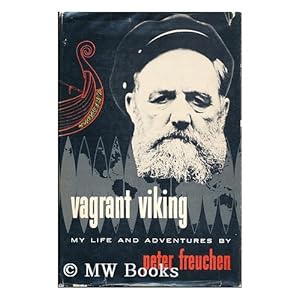Credit: Amazon
Most of us probably know very little about Eskimo life or culture. Here’s the book that will fix that, while at the same time giving you real insight into what it takes to survive in the Arctic. Part of our fascination with Eskimo life has to be their ability to build and hunt with skin kayaks, a part of their heritage we enjoy today.
Peter Freuchen was born in February, 1886, of a Danish father and Eskimo mother. While still young, he visited Greenland with his mother to see her family. He was totally captivated by what he saw, and by age 20 was on his first Arctic expedition when polar exploration was in its infancy. He became an expedition leader that traveled with Cook, Rasmussen, Amundsen, and others, and became an accomplished writer for newspapers, magazines, and the screen. Freuchen decided to stay in Greenland, except when he was home in Denmark outfitting another Arctic expedition. These are just a couple stories to elicit some curiosity about this man and his experiences.
He met an attractive Eskimo girl who drew his excited attention. He finally asked her to a dance, the only form of recreation in the frozen Arctic, and unlikely anything we would visualize when we think of a dance. She asked him to follow her home so she could get ready, and they would go directly to the dance from there. Living in such close proximity in igloos and snow houses, Eskimos seem to totally lack any idea of modesty, so she undressed and changed right in front of this young man she had just met. She then pulled the slop pot out and removed its lid. It was brimming full of urine, which they keep for cleaning, hide tanning, and---washing hair. She let her hair fall, which cascaded almost to the floor, and lowered it into the pot to wash it. Once she was ready, they went on to the dance, but he said having her hair next to his face and nose all night unavoidably cooled his fascination with the girl. He was married three times. His first wife was indeed an Eskimo, who died in 1921 in a Spanish flu epidemic, after bearing Peter two children. He was later elected as a Member of Parliament in Canada, and served there until 1984.
I found the Eskimo’s ability to live in the Arctic environment difficult to fathom. The most bizarre fiction could never touch some of the strange things people do in that environment to survive. Freuchen tells of one trip home when it was not at all clear if he would live. There are no landmarks. The world up there is as barren as the sea, and for much of the time during the winter, a frozen sea of ice is what inhabitants traverse. Searching the horizon in all directions reveals nothing but shades of gray. A compass is almost useless in the Arctic, and getting lost is a fact of life. The best guides are old sled tracks from earlier travelers. The wind was blowing hurricane force during this trip, and the temperature was 54-degrees below zero. Even the dogs tried to refuse moving, but he forced them on. He found an overhanging ledge with some bare ground beneath. The dogs had already dived in as he considered that this may be his only chance for survival. He pulled the sled across the cavity in the snow and ice and crawled under.
He awoke some hours later in pitch dark. He didn’t know if it was night or day. He only knew that the snow drift had become so deep that he had been buried alive, and in a spot barely the size of a coffin. He couldn’t move. After some time, he was able to work one arm free and clawed away at the ice to burrow a small hole to the surface so he could get enough air to breathe. When he neared the surface, he could see light through the ice, and realized that it was daylight outside.
He continued trying to dig as the ice ripped his fingers. The ice and snow he broke loose fell into his diminishing space, and worked its way into his hood and down his neck and back and inside of his parka. The sled was covered with maybe a ton of ice. If he could keep digging around the front of the sled, he hoped he could get an arm free and find his ice knife on the sled. Peter finally got his head and arm part way out when his whiskers touched and instantly froze fast to the sled runner. He was trapped, unable to get out or back in. He finally had to pull until he ripped the whiskers and part of his flesh from his face, leaving them frozen to the sled runner. He did get out, and you will never guess how he did it. For that, you need to read the book. He had both feet frozen in this ordeal, and one could not be saved as it turned black and rotted. There were no medical facilities, and he would have to wait until the thaw the next summer before he could get back to Denmark to have his leg amputated. In the meanwhile, he had to pick the flesh from his leg as it died, and hobbled about on the exposed leg bone. For real stories about survival and a fascinating life, this is it.

No comments:
Post a Comment